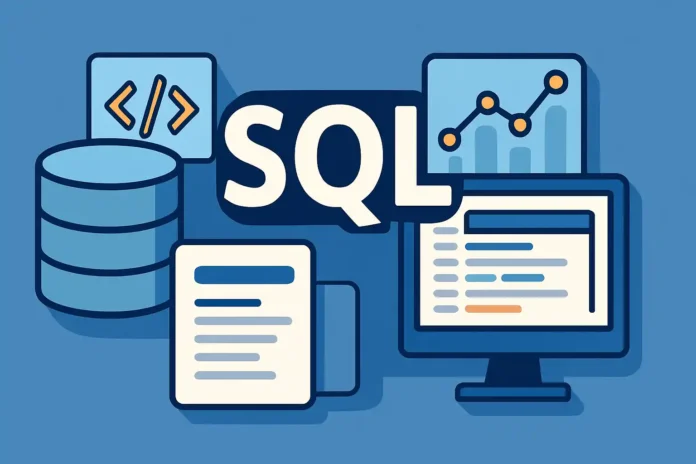Table of Contents
- Introduction
- What is a Self-Join?
- When Do You Use a Self-Join?
- Basic Syntax of a Self-Join
- Real-World Example: Employees and Managers
- Using Table Aliases in Self-Joins
- Self-Join with WHERE Clause
- Self-Join with SELECT and Filtering
- Self-Join for Hierarchical Relationships
- Self-Join for Finding Pairs (e.g., Roommates)
- Self-Join with NULLs
- LEFT JOIN as a Self-Join
- Self-Join with Aggregates
- Common Use Case: Product Comparisons
- Self-Join for Temporal Comparisons (Dates)
- Performance Considerations
- Common Errors in Self-Joins
- Best Practices for Self-Joins
- Visualizing Self-Joins
- Summary and What’s Next
1. Introduction
A self-join is a regular JOIN, but instead of joining two different tables, you join a table to itself. It is particularly useful in dealing with hierarchical, recursive, or comparative data within a single table.
2. What is a Self-Join?
A self-join is a SQL query where a table is joined with itself using aliases to differentiate the two instances. It behaves like a normal join but compares rows within the same table.
3. When Do You Use a Self-Join?
- To link parent-child relationships (e.g., employees and managers)
- To compare rows within a table
- To traverse hierarchical structures
- To generate row combinations without duplication
4. Basic Syntax of a Self-Join
sqlCopyEditSELECT a.column, b.column
FROM table AS a
JOIN table AS b
ON a.column = b.column;
Use different aliases to treat the table as two logical entities.
5. Real-World Example: Employees and Managers
employees
| id | name | manager_id |
|---|---|---|
| 1 | Ravi | NULL |
| 2 | Sneha | 1 |
| 3 | Aditya | 1 |
sqlCopyEditSELECT e.name AS employee, m.name AS manager
FROM employees e
LEFT JOIN employees m ON e.manager_id = m.id;
Result:
| employee | manager |
|---|---|
| Ravi | NULL |
| Sneha | Ravi |
| Aditya | Ravi |
6. Using Table Aliases in Self-Joins
Always alias the table to distinguish roles:
sqlCopyEditFROM employees AS e
JOIN employees AS m ON e.manager_id = m.id
This makes logic clear and prevents ambiguity.
7. Self-Join with WHERE Clause
Example: Find employees who report to the same manager
sqlCopyEditSELECT e1.name AS emp1, e2.name AS emp2
FROM employees e1
JOIN employees e2 ON e1.manager_id = e2.manager_id
WHERE e1.id < e2.id;
This avoids duplicate and reversed pairs.
8. Self-Join with SELECT and Filtering
Find employees who have a manager in a specific city:
sqlCopyEditSELECT e.name AS employee, m.name AS manager
FROM employees e
JOIN employees m ON e.manager_id = m.id
WHERE m.city = 'Delhi';
9. Self-Join for Hierarchical Relationships
Useful for navigating tree-like structures such as:
- Category hierarchies
- Folder trees
- Organizational charts
sqlCopyEditSELECT c1.name AS child, c2.name AS parent
FROM categories c1
JOIN categories c2 ON c1.parent_id = c2.id;
10. Self-Join for Finding Pairs (e.g., Roommates)
sqlCopyEditSELECT a.name AS person1, b.name AS person2
FROM people a
JOIN people b ON a.room_id = b.room_id
WHERE a.id < b.id;
Avoids showing both (A, B) and (B, A).
11. Self-Join with NULLs
If some rows have no reference (e.g., no manager):
sqlCopyEditSELECT e.name, m.name
FROM employees e
LEFT JOIN employees m ON e.manager_id = m.id;
Still shows employees without managers.
12. LEFT JOIN as a Self-Join
When the relationship might not exist:
sqlCopyEditSELECT a.name, b.name
FROM items a
LEFT JOIN items b ON a.related_item_id = b.id;
13. Self-Join with Aggregates
Example: For each employee, show how many peers they have under the same manager.
sqlCopyEditSELECT e.name, COUNT(p.id) AS peers
FROM employees e
JOIN employees p ON e.manager_id = p.manager_id
WHERE e.id != p.id
GROUP BY e.name;
14. Common Use Case: Product Comparisons
sqlCopyEditSELECT a.name AS product1, b.name AS product2
FROM products a
JOIN products b ON a.category_id = b.category_id
WHERE a.id < b.id;
Used in recommendation systems or variant matchups.
15. Self-Join for Temporal Comparisons (Dates)
Find overlapping shifts, events, or appointments:
sqlCopyEditSELECT a.id, b.id
FROM events a
JOIN events b ON a.start_time < b.end_time AND a.end_time > b.start_time
WHERE a.id != b.id;
16. Performance Considerations
- Index keys used in self-joins (like
manager_id) - Use
WHERE a.id < b.idto limit redundant comparisons - Avoid large self-joins without filters — performance may degrade quickly
17. Common Errors in Self-Joins
| Mistake | Result |
|---|---|
| Missing aliases | Ambiguous column error |
| No filtering of duplicates | Redundant rows |
Using = instead of </!= | Duplicate or reflexive matches |
| Forgetting to handle NULLs | Excludes unlinked rows unintentionally |
18. Best Practices for Self-Joins
- Use meaningful table aliases
- Filter using
a.id < b.idto avoid duplicate pairings - Document complex conditions
- Use
LEFT JOINfor optional relationships - Limit results to what you need — no
SELECT *
19. Visualizing Self-Joins
A self-join connects a row to another row in the same table. Imagine a line from an employee to their manager — both records exist in the same table, but play different roles.
20. Summary and What’s Next
Self-joins are indispensable when querying hierarchical data, comparing rows in a single table, or modeling relationships that are internal to a table. While conceptually simple, they’re a powerful part of advanced SQL.


